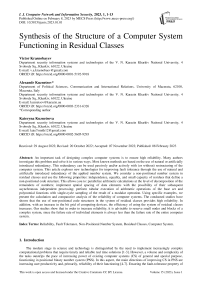Synthesis of the Structure of a Computer System Functioning in Residual Classes
Автор: Victor Krasnobayev, Alexandr Kuznetsov, Kateryna Kuznetsova
Журнал: International Journal of Computer Network and Information Security @ijcnis
Статья в выпуске: 1 vol.15, 2023 года.
Бесплатный доступ
An important task of designing complex computer systems is to ensure high reliability. Many authors investigate this problem and solve it in various ways. Most known methods are based on the use of natural or artificially introduced redundancy. This redundancy can be used passively and/or actively with (or without) restructuring of the computer system. This article explores new technologies for improving fault tolerance through the use of natural and artificially introduced redundancy of the applied number system. We consider a non-positional number system in residual classes and use the following properties: independence, equality, and small capacity of residues that define a non-positional code structure. This allows you to: parallelize arithmetic calculations at the level of decomposition of the remainders of numbers; implement spatial spacing of data elements with the possibility of their subsequent asynchronous independent processing; perform tabular execution of arithmetic operations of the base set and polynomial functions with single-cycle sampling of the result of a modular operation. Using specific examples, we present the calculation and comparative analysis of the reliability of computer systems. The conducted studies have shown that the use of non-positional code structures in the system of residual classes provides high reliability. In addition, with an increase in the bit grid of computing devices, the efficiency of using the system of residual classes increases. Our studies show that in order to increase reliability, it is advisable to reserve small nodes and blocks of a complex system, since the failure rate of individual elements is always less than the failure rate of the entire computer system.
Reliability, Fault Tolerance, Non-Positional Number System, Residual Classes, Computer System
Короткий адрес: https://sciup.org/15018560
IDR: 15018560 | DOI: 10.5815/ijcnis.2023.01.01
Список литературы Synthesis of the Structure of a Computer System Functioning in Residual Classes
- R. F. Hodson, Real-Time Expert Systems Computer Architecture. CRC Press, 2018. doi: 10.1201/9781351076203.
- R. S. Alford, Computer Systems Engineering Management. CRC Press, 2018. doi: 10.1201/9781351070829.
- A. Yadin, Computer Systems Architecture, 1st ed. Boca Raton : Taylor & Francis Group, CRC Press, 2016. | Series: Chapman and Hall/CRC, 2016. doi: 10.1201/9781315373287.
- I. Koren and C. M. Krishna, “Fault-Tolerant Networks,” in Fault-Tolerant Systems, Elsevier, 2021, pp. 115–159. doi: 10.1016/B978-0-12-818105-8.00014-0.
- Q. Hu, B. Xiao, B. Li, and Y. Zhang, “Fault-tolerant velocity-free attitude control,” in Fault-Tolerant Attitude Control of Spacecraft, Elsevier, 2021, pp. 125–173. doi: 10.1016/B978-0-32-389863-8.00015-0.
- S. X. Ding, “Performance Recovery and Fault-Tolerant Control Schemes,” in Advanced methods for fault diagnosis and fault-tolerant control, Berlin, Heidelberg: Springer Berlin Heidelberg, 2021, pp. 553–600. doi: 10.1007/978-3-662-62004-5_20.
- P. Castaldi, N. Mimmo, and S. Simani, “Fault diagnosis and fault-tolerant control techniques for aircraft systems,” in Fault Diagnosis and Fault-tolerant Control of Robotic and Autonomous Systems, A. Monteriu, A. Freddi, and S. Longhi, Eds. Institution of Engineering and Technology, 2020, pp. 197–212. doi: 10.1049/PBCE126E_ch9.
- A. M. Polovko, Fundamentals of reliability theory. Published: New York - London: Academic Press., 1968.
- I. A. Ushakov, Ed., Optimal Resource Allocation: With Practical Statistical Applications and Theory. Hoboken, NJ, USA: John Wiley & Sons, Inc., 2013. doi: 10.1002/9781118400715.
- I. Koren and C. M. Krishna, “Chapter 2 - Hardware Fault Tolerance,” in Fault-Tolerant Systems (Second Edition), I. Koren and C. M. Krishna, Eds. San Francisco (CA): Morgan Kaufmann, 2021, pp. 11–57. doi: 10.1016/B978-0-12-818105-8.00012-7.
- V. Krasnobayev, A. Kuznetsov, A. Yanko, B. Akhmetov, and T. Kuznetsova, “Processing of the Residuals of Numbers in Real and Complex Numerical Domains,” in Data-Centric Business and Applications, vol. 48, T. Radivilova, D. Ageyev, and N. Kryvinska, Eds. Cham: Springer International Publishing, 2021, pp. 529–555. doi: 10.1007/978-3-030-43070-2_24.
- V. Krasnobayev, A. Kuznetsov, S. Koshman, and S. Moroz, “Improved Method of Determining the Alternative Set of Numbers in Residue Number System,” in Recent Developments in Data Science and Intelligent Analysis of Information, vol. 836, O. Chertov, T. Mylovanov, Y. Kondratenko, J. Kacprzyk, V. Kreinovich, and V. Stefanuk, Eds. Cham: Springer International Publishing, 2019, pp. 319–328. doi: 10.1007/978-3-319-97885-7_31.
- V. Krasnobaev, A. Kuznetsov, V. Popenko, and T. Kuznetsova, “Mathematical Model of the Reliability of a Computer System which is Functioning in the Residual Class System, Taking into Account the Reliability of Switching Devices,” in 2021 IEEE 4th International Conference on Advanced Information and Communication Technologies (AICT), Sep. 2021, pp. 225–229. doi: 10.1109/AICT52120.2021.9628929.
- V. Piuri, “Fault-tolerant systolic arrays: An approach based upon residue arithmetic,” in 1987 IEEE 8th Symposium on Computer Arithmetic (ARITH), May 1987, pp. 230–238. doi: 10.1109/ARITH.1987.6158712.
- M. H. Weik, “computer system fault tolerance,” in Computer Science and Communications Dictionary, M. H. Weik, Ed. Boston, MA: Springer US, 2001, pp. 274–274. doi: 10.1007/1-4020-0613-6_3420.
- I. A. Ushakov, “Formulation of Optimal Redundancy Problems,” in Optimal Resource Allocation, John Wiley & Sons, Ltd, 2013, pp. 33–47. doi: 10.1002/9781118400715.ch2.
- I. A. Ushakov, “Dynamic Programming,” in Optimal Resource Allocation, John Wiley & Sons, Ltd, 2013, pp. 69–84. doi: 10.1002/9781118400715.ch5.
- V. Krasnobaev, A. Kuznetsov, A. Kiian, and K. Kuznetsova, “Fault Tolerance Computer System Structures Functioning in Residue Classes,” in 2021 11th IEEE International Conference on Intelligent Data Acquisition and Advanced Computing Systems: Technology and Applications (IDAACS), Sep. 2021, vol. 1, pp. 471–474. doi: 10.1109/IDAACS53288.2021.9660919.
- Y. Zhang, “An FPGA implementation of redundant residue number system for low-cost fast speed fault-tolerant computations,” Thesis, 2018. doi: 10.32657/10220/47113.
- Ya. M. Nikolaychuk, Specialized computer technologies in information. Ternopil: TzOV «Terno-graph», 2017.
- P. V. A. Mohan, Residue Number Systems. Cham: Springer International Publishing, 2016. doi: 10.1007/978-3-319-41385-3.
- I. Koren, “THE RESIDUE NUMBER SYSTEM,” Computer Arithmetic Algorithms, Oct. 08, 2018. https://www.taylorfrancis.com/ (accessed Aug. 16, 2020).


